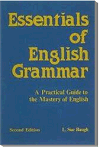

| Book of the Month | ||
 |
Essentials of English Grammar (Second Edition) |  |
Publisher: Passport Books
Author: L. Sue Baugh
$6.95
ISBN 0-8442-5821-0
There are many ways to learn English. Some people prefer to learn 'naturally' - by mixing with native speakers, watching English language films and reading books and newspapers in English. However, it has been shown that the fastest and best way to become proficient in a language is to learn the grammar. This small book is for those people who agree with this approach. It has no pictures, cartoons or jokes; every page is packed with neatly-arranged information about English grammar. The author's intention is to provide as comprehensive a reference book as possible in the space available. This approach obviously has its supporters, as this book is one of a series which also teaches the essential grammar of Hindi, Latin, Swedish and other languages.
There are just 146 pages in this book. This means that even the most important points have to be dealt with briefly, because the text covers not just grammar but also style and punctuation. There are also appendices with lists of frequently misspelled and misunderstood words, and even a list of correction symbols. The first half of the book covers the 'Essentials of grammar', going in a logical way through nouns, pronouns, verbs, adverbs and so on. This means that the entire verb system of English is dealt with between pages 12 and 20. This is nowhere near enough for those wanting to learn - for example - the uses of the present perfect or the difference between indicative and subjunctive. However, it would work as a handy reference for those who need to check or revise English tenses once they have been learned. The 'style' section takes up the next hundred pages, and gives good advice on matters such as why active verbs are better than passive verbs on most occasions, and stresses the importance of clarity. It is unfortunate that six pages of the book have been used for a digression on 'gender-inclusive language'. Some of the suggesions are common sense, but at other times the author seems to wish to rewrite the rules of grammar - for example that the male pronoun includes the female when describing both. For this author the sentence 'A good dentist cares for his patients' is, if not wrong, at least something to avoid. Discussing this issue takes up almost as much of the book as the description of the complete English verb system.
Who is this book for? Anyone who wants to check that a particular usage is correct, whether stylistically or grammatically, will probably find the answer in this well-organized and surprisingly comprehehensive little book. However, the language is very dry and a student attempting to learn English from this text will find it hard work as even important topics are dealt with very briefly. Overall, this book is best used as a guide to correct usage and to help those who already know English but have never formally learned the grammar of the language.
Verdict: Best for revision
Assessment 6/10